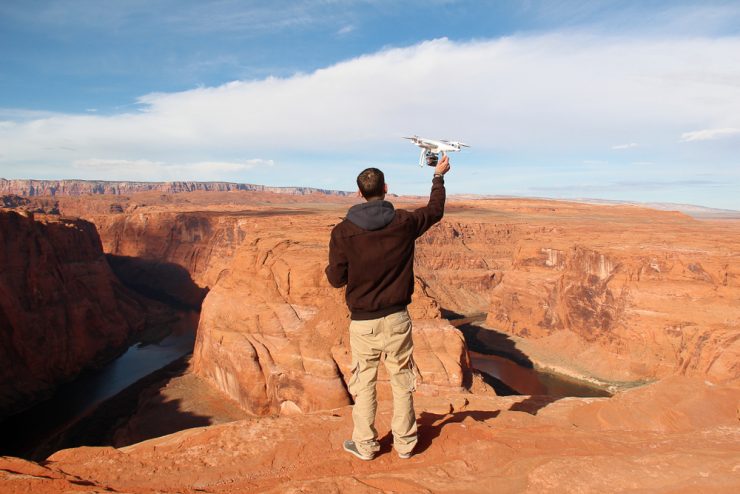By Jenny Beechener
The US Federal Aviation Administration (FAA) released its Aerospace Forecast 2020-2040 at the end of March 2020. The FAA forecasts that the commercial UAS fleet by 2024 will likely (base scenario) be more than twice as large as the current number of commercial UAS. As the present base (the cumulative total) increases, the FAA anticipates the growth rate of the sector will slow down over time. Nevertheless, the sector will be much larger than what was understood only a few years ago. Given the accelerated registration over the last year, the FAA now projects the commercial sUAS sector will have around 828,000 aircraft in 2024, the end of the 5-year period.
The agency recorded more than 108,000 registrations by commercial operators in 2019, or about 10,000 every month. The pace of registration is slowing down in comparison to 2018, but still relatively high. By the end of 2019, there were more than 385,000 commercial UAS registered since the registration for part 107 or commercial sUAS opened in April 2016. According to the forecast, the FAA anticipates that the growth rate in this sector will remain high over the next few years. This is primarily driven by the clarity that part 107 has provided to the industry, for example proposed new rule changes for operations over people and at night without waivers and remote identification.
Furthermore, the forecast predicts: Given the possibilities for waivers, including enhancement of operational efficiencies under increasingly well-defined concepts of operations (CONOPS) — which ensures safety and transparent information flow across the community — more and more commercial uses will become likely, fueling even further growth. Notably, one such place for receiving all operational information, including registration, authorization, and logging accident reports, helps facilitate this growth further [https://faadronezone.faa.gov/#/].
In order to understand the growth trajectory of the sector better, the forecast divides the commercial UAS sector into two types of sUAS aircraft: consumer grade and professional grade. The consumer grade commercial sUAS have a wide range of prices, below USD10,000 with an average unit price of approximately USD2,500. The professional grade is typically priced above USD10,000 with an average unit price assumed to be around USD25,000. For both consumer grade and professional grade UAS, the average price is falling over time, particularly over the last few years. Currently, the consumer grade dominates the commercial UAS sector with a market share approaching 94%. However, as the sector matures and the industry begins to consolidate, the share of consumer grade commercial UAS is likely to decline, though it will still be dominant. By 2024, FAA projects this sub-sector will have approximately 85% of the overall commercial sUAS sector.
Starting from a low base of approximately 25,000 aircraft in 2019, the professional grade commercial sUAS sub-sector stands to expand rapidly over time, especially as newer and more sophisticated uses are identified, designed, and operationally planned and flown. If, for example, professional grade sUAS meet feasibility criteria of operations, safety, regulations, and satisfy economics and business principles and enters into the logistics chain via small package delivery, the growth in this sector will likely be phenomenal. This growth trajectory could be even further enhanced by expanding operations, for example the Low Altitude Authorization and Notification Capability (LAANC) system, which began authorization in May, 2018. While most of the near-term growth in commercial sUAS will continue to come from consumer grade units (over 90%), the FAA anticipates a significant part will come from professional grade sUAS as well.
An important final metric in commercial sUAS is the trend in remote pilot (RP) certifications. RPs are used primarily to facilitate commercial sUAS flights. As of December 2019, 162,185 RP certifications had been issued. RPs are set to experience tremendous growth following the growth trends of the commercial sUAS sector. Starting from the base of 162,185 RPs in 2019, commercial activities may require almost 350,000 RPs in 5 years, more than two-fold increase, providing tremendous opportunities for growth in employment associated with commercial activities of UAS. Potential for RPs may enhance even more if larger UAS are used in commercial activities and urban air mobility become a reality in the near future.
Recreational sUAS
The agency recorded a 6.4% growth in the size of the sUAS recreational fleet to 1.32 million drones. Based on the trend in registration and market developments, the forecast predicts this market will saturate at around 1.5 million units within five years. The figures are based on the registrations by recreational operators of small UAS (sUAS) which reached around 990,000 at the end of 2019. This is distributed countrywide with denser ownership mapping closely against population centres.
For more information visit:
(Image: Shutterstock)




